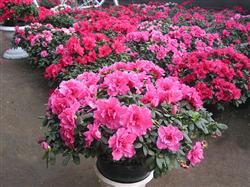How do azaleas grow without soil?

How do azaleas grow without soil? Please give guidance on soilless cultivation methods of rhododendron can refer to the following methods: 1. preparation of substrate Rhododendron root system is very thin, requiring loose matrix, in order to facilitate ventilation, drainage. 1 part of vermiculite, 1 part of pearl sand, 1 part of river sand and 1 part of coal cinder are mixed according to a proportion. After mixing, the matrix was sterilized with 0.1% carbendazim solution, evenly mixed into the matrix, and covered with plastic film for 1 day. Then wash with clean water for many times, dry, mix well with 0.4% agricultural compound fertilizer solution, cover with plastic film for one month, and then use on the basin. 2. Preparation of nutrient solution Azaleas have strict requirements for fertilizer. During the growing season, thin fertilizer is applied frequently. According to experiments, agricultural compound fertilizer as the main, supplemented by trace elements, PH value control at about 5, spraying low concentration of foliar fertilizer, can receive good results. The preparation of macroelements: 1 liter of water plus 2 grams of agricultural compound fertilizer, and then add 0.5 grams of magnesium sulfate, as a standard solution. The preparation of trace elements: 1 liter of water, 20 grams of disodium EDTA, 15 grams of ferrous sulfate, 4 grams of manganese sulfate, 6 grams of boric acid, 0.2 grams of zinc sulfate, 0.1 grams of copper sulfate, 0.2 grams of ammonium molybdate as mother liquor. When using, add 1 ml of trace element mother solution to 1 liter of standard solution, that is, the full amount of elements. The preparation of foliar fertilizer: 1g urea, 1g potassium dihydrogen phosphate, 0.02g boric acid and 0.1g V.B1 are added to 1L water. 3. water and fertilizer management Because the substrate drainage, permeability is good; but poor water retention, so the amount of watering is generally more than the soil culture, in order to keep the substrate moist can be; at this time is pregnant buds, leaf buds germination, need a large amount of fertilizer, about 10 days to irrigate a full amount of nutrient solution. From March to bud flaws, spray foliar fertilizer once every 15 days. After flowering, water demand is large, in addition to watering every day, in the evening to carry out foliar watering. At this time, the amount of fertilizer required is also large, and it can be changed to irrigate nutrient solution once a week, and spray foliar fertilizer once to promote the new branches to be strong, so as to facilitate flower bud differentiation. After entering the ambush, pay attention to keeping the substrate moist, and sprinkle water on the leaves, and the amount of fertilizer can be reduced to about 20 days to irrigate nutrient solution. After autumn cool, can gradually increase the amount of fertilizer, half a month or so apply a full amount of nutrient solution, and spray 1-2 times foliar fertilizer, promote bud robust growth. After winter, azalea physiological activity weak, not suitable for fertilization, depending on the degree of substrate moisture can be properly watered. In the cultivation process, basically no diseases and insect pests occurred. Click for more rhododendron planting techniques Click for more flower planting techniques
- Prev

How to prevent and cure root rot of rhododendron?
How to prevent and cure root rot of rhododendron? Root rot is a serious threat to rhododendron, although its incidence is not high, but the mortality rate is very high, so we must pay attention to the prevention and control of root rot in the cultivation and management of rhododendron. Root rot is a soil-borne disease caused by Fusarium oxysporum.
- Next

What are the common diseases of rhododendron?
What are the common diseases of rhododendron? Please introduce and guide the prevention and control methods of cuckoo common diseases are as follows: rhododendron leaf spot symptoms mainly infect leaves, at the initial stage, the leaves appear reddish brown spots, gradually expand into disease spots or irregular polygonal spots, dark brown. In the later stage, the disease spot.
Related
- Fuxing push coffee new agricultural production and marketing class: lack of small-scale processing plants
- Jujube rice field leisure farm deep ploughing Yilan for five years to create a space for organic food and play
- Nongyu Farm-A trial of organic papaya for brave women with advanced technology
- Four points for attention in the prevention and control of diseases and insect pests of edible fungi
- How to add nutrient solution to Edible Fungi
- Is there any good way to control edible fungus mites?
- Open Inoculation Technology of Edible Fungi
- Is there any clever way to use fertilizer for edible fungus in winter?
- What agents are used to kill the pathogens of edible fungi in the mushroom shed?
- Rapid drying of Edible Fungi

